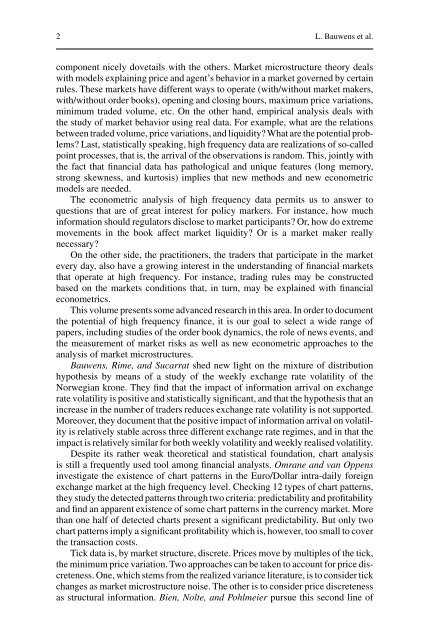recent developments in high frequency financial ... - Index of
recent developments in high frequency financial ... - Index of
recent developments in high frequency financial ... - Index of
You also want an ePaper? Increase the reach of your titles
YUMPU automatically turns print PDFs into web optimized ePapers that Google loves.
2 L. Bauwens et al.<br />
component nicely dovetails with the others. Market microstructure theory deals<br />
with models expla<strong>in</strong><strong>in</strong>g price and agent’s behavior <strong>in</strong> a market governed by certa<strong>in</strong><br />
rules. These markets have different ways to operate (with/without market makers,<br />
with/without order books), open<strong>in</strong>g and clos<strong>in</strong>g hours, maximum price variations,<br />
m<strong>in</strong>imum traded volume, etc. On the other hand, empirical analysis deals with<br />
the study <strong>of</strong> market behavior us<strong>in</strong>g real data. For example, what are the relations<br />
between traded volume, price variations, and liquidity? What are the potential problems?<br />
Last, statistically speak<strong>in</strong>g, <strong>high</strong> <strong>frequency</strong> data are realizations <strong>of</strong> so-called<br />
po<strong>in</strong>t processes, that is, the arrival <strong>of</strong> the observations is random. This, jo<strong>in</strong>tly with<br />
the fact that f<strong>in</strong>ancial data has pathological and unique features (long memory,<br />
strong skewness, and kurtosis) implies that new methods and new econometric<br />
models are needed.<br />
The econometric analysis <strong>of</strong> <strong>high</strong> <strong>frequency</strong> data permits us to answer to<br />
questions that are <strong>of</strong> great <strong>in</strong>terest for policy markers. For <strong>in</strong>stance, how much<br />
<strong>in</strong>formation should regulators disclose to market participants? Or, how do extreme<br />
movements <strong>in</strong> the book affect market liquidity? Or is a market maker really<br />
necessary?<br />
On the other side, the practitioners, the traders that participate <strong>in</strong> the market<br />
every day, also have a grow<strong>in</strong>g <strong>in</strong>terest <strong>in</strong> the understand<strong>in</strong>g <strong>of</strong> f<strong>in</strong>ancial markets<br />
that operate at <strong>high</strong> <strong>frequency</strong>. For <strong>in</strong>stance, trad<strong>in</strong>g rules may be constructed<br />
based on the markets conditions that, <strong>in</strong> turn, may be expla<strong>in</strong>ed with f<strong>in</strong>ancial<br />
econometrics.<br />
This volume presents some advanced research <strong>in</strong> this area. In order to document<br />
the potential <strong>of</strong> <strong>high</strong> <strong>frequency</strong> f<strong>in</strong>ance, it is our goal to select a wide range <strong>of</strong><br />
papers, <strong>in</strong>clud<strong>in</strong>g studies <strong>of</strong> the order book dynamics, the role <strong>of</strong> news events, and<br />
the measurement <strong>of</strong> market risks as well as new econometric approaches to the<br />
analysis <strong>of</strong> market microstructures.<br />
Bauwens, Rime, and Sucarrat shed new light on the mixture <strong>of</strong> distribution<br />
hypothesis by means <strong>of</strong> a study <strong>of</strong> the weekly exchange rate volatility <strong>of</strong> the<br />
Norwegian krone. They f<strong>in</strong>d that the impact <strong>of</strong> <strong>in</strong>formation arrival on exchange<br />
rate volatility is positive and statistically significant, and that the hypothesis that an<br />
<strong>in</strong>crease <strong>in</strong> the number <strong>of</strong> traders reduces exchange rate volatility is not supported.<br />
Moreover, they document that the positive impact <strong>of</strong> <strong>in</strong>formation arrival on volatility<br />
is relatively stable across three different exchange rate regimes, and <strong>in</strong> that the<br />
impact is relatively similar for both weekly volatility and weekly realised volatility.<br />
Despite its rather weak theoretical and statistical foundation, chart analysis<br />
is still a frequently used tool among f<strong>in</strong>ancial analysts. Omrane and van Oppens<br />
<strong>in</strong>vestigate the existence <strong>of</strong> chart patterns <strong>in</strong> the Euro/Dollar <strong>in</strong>tra-daily foreign<br />
exchange market at the <strong>high</strong> <strong>frequency</strong> level. Check<strong>in</strong>g 12 types <strong>of</strong> chart patterns,<br />
they study the detected patterns through two criteria: predictability and pr<strong>of</strong>itability<br />
and f<strong>in</strong>d an apparent existence <strong>of</strong> some chart patterns <strong>in</strong> the currency market. More<br />
than one half <strong>of</strong> detected charts present a significant predictability. But only two<br />
chart patterns imply a significant pr<strong>of</strong>itability which is, however, too small to cover<br />
the transaction costs.<br />
Tick data is, by market structure, discrete. Prices move by multiples <strong>of</strong> the tick,<br />
the m<strong>in</strong>imum price variation. Two approaches can be taken to account for price discreteness.<br />
One, which stems from the realized variance literature, is to consider tick<br />
changes as market microstructure noise. The other is to consider price discreteness<br />
as structural <strong>in</strong>formation. Bien, Nolte, and Pohlmeier pursue this second l<strong>in</strong>e <strong>of</strong>










